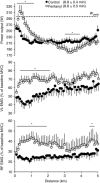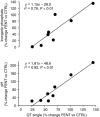Group III/IV muscle afferents limit the intramuscular metabolic perturbation during whole body exercise in humans
- PMID: 27241818
- PMCID: PMC5023715
- DOI: 10.1113/JP272283
Group III/IV muscle afferents limit the intramuscular metabolic perturbation during whole body exercise in humans
Abstract
Key points: The purpose of this study was to determine the role of group III/IV muscle afferents in limiting the endurance exercise-induced metabolic perturbation assayed in muscle biopsy samples taken from locomotor muscle. Lumbar intrathecal fentanyl was used to attenuate the central projection of μ-opioid receptor-sensitive locomotor muscle afferents during a 5 km cycling time trial. The findings suggest that the central projection of group III/IV muscle afferent feedback constrains voluntary neural 'drive' to working locomotor muscle and limits the exercise-induced intramuscular metabolic perturbation. Therefore, the CNS might regulate the degree of metabolic perturbation within locomotor muscle and thereby limit peripheral fatigue. It appears that the group III/IV muscle afferents are an important neural link in this regulatory mechanism, which probably serves to protect locomotor muscle from the potentially severe functional impairment as a consequence of severe intramuscular metabolic disturbance.
Abstract: To investigate the role of metabo- and mechanosensitive group III/IV muscle afferents in limiting the intramuscular metabolic perturbation during whole body endurance exercise, eight subjects performed 5 km cycling time trials under control conditions (CTRL) and with lumbar intrathecal fentanyl impairing lower limb muscle afferent feedback (FENT). Vastus lateralis muscle biopsies were obtained before and immediately after exercise. Motoneuronal output was estimated through vastus lateralis surface electromyography (EMG). Exercise-induced changes in intramuscular metabolites were determined using liquid and gas chromatography-mass spectrometry. Quadriceps fatigue was quantified by pre- to post-exercise changes in potentiated quadriceps twitch torque (ΔQTsingle ) evoked by electrical femoral nerve stimulation. Although motoneuronal output was 21 ± 12% higher during FENT compared to CTRL (P < 0.05), time to complete the time trial was similar (∼8.8 min). Compared to CTRL, power output during FENT was 10 ± 4% higher in the first half of the time trial, but 11 ± 5% lower in the second half (both P < 0.01). The exercise-induced increase in intramuscular inorganic phosphate, H(+) , adenosine diphosphate, lactate and phosphocreatine depletion was 55 ± 30, 62 ± 18, 129 ± 63, 47 ± 14 (P < 0.001) and 27 ± 14% (P < 0.01) greater in FENT than CTRL. ΔQTsingle was greater following FENT than CTRL (-52 ± 2 vs -31 ± 1%, P < 0.001) and this difference was positively correlated with the difference in inorganic phosphate (r(2) = 0.79; P < 0.01) and H(+) (r(2) = 0.92; P < 0.01). In conclusion, during whole body exercise, group III/IV muscle afferents provide feedback to the CNS which, in turn, constrains motoneuronal output to the active skeletal muscle. This regulatory mechanism limits the exercise-induced intramuscular metabolic perturbation, preventing an abnormal homeostatic challenge and excessive peripheral fatigue.
© 2016 The Authors. The Journal of Physiology © 2016 The Physiological Society.
Figures




References
-
- Allen DG, Lamb GD & Westerblad H (2008). Skeletal muscle fatigue: cellular mechanisms. Physiol Rev 88, 287–332. - PubMed
-
- Almeida TF, Roizenblatt S & Tufik S (2004). Afferent pain pathways: a neuroanatomical review. Brain Res 1000, 40–56. - PubMed
-
- Amann M (2011). Central and peripheral fatigue: interaction during cycling exercise in humans. Med Sci Sports Exerc 43, 2039–2045. - PubMed
Publication types
MeSH terms
Substances
Grants and funding
LinkOut - more resources
Full Text Sources
Other Literature Sources
Medical
Research Materials

